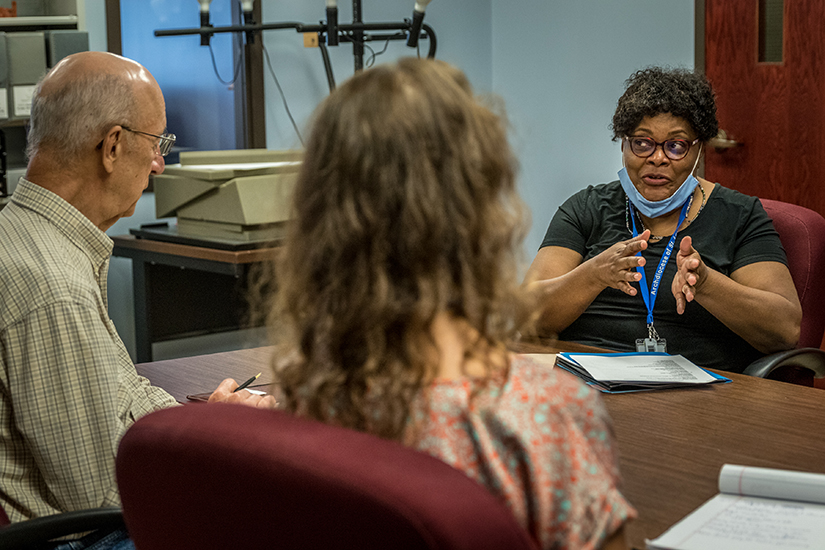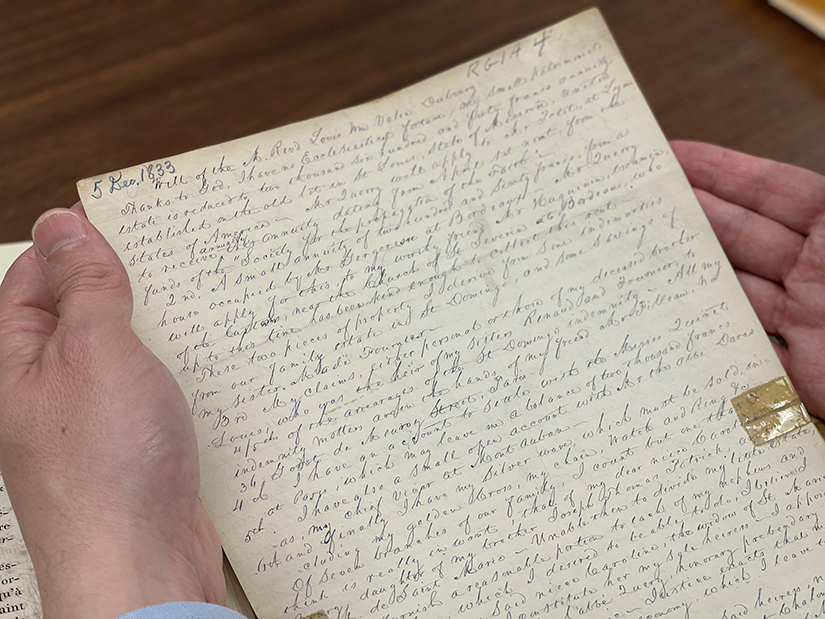Not much is known about Harry and Jenny. Their last name is listed in records with several variations: Nebbit, Nibbit and Nesbit. But what is known is that the couple, who were enslaved for much of their lives, was purchased by Bishop William DuBourg in 1822, along with the couple’s nine children at the time.
Five years later, their ownership was transferred to Bishop DuBourg’s successor, Bishop Joseph Rosati. Jenny died in Perry County in 1829; Harry is believed to have died in a tornado at St. Vincent’s College in Cape Girardeau in 1850.
One of their children, Eliza “Liza” was transferred by Bishop DuBourg to St. Rose Philippine Duchesne and the Religious of the Sacred Heart. One of their sons, Clement, was sold to Father Jean-Marie Odin, a Vincentian, who had Clement and his family sent to him in Galveston, where he would become the first bishop of the new Diocese of Galveston in 1847.
 Program director of the Archdiocese of St. Louis Racial Harmony Joyce Jones addressed volunteer researcher Emory Webre as they met with the director of archives Eric Fair and archivist Rena Schergen at the Cardinal Rigali Center May 26. The group was discussing research into historically enslaved people.Photo Credits: Lisa JohnstonThe family is among the first glimpses of African-Americans who were enslaved by numerous bishops and clergy in the Archdiocese of St. Louis in the 19th century. The archdiocesan Office of Archives and Records has been researching the archdiocese’s involvement in the institution of slavery since 2018; the project was formally named “Forgive Us Our Trespasses” in February of 2021.
Program director of the Archdiocese of St. Louis Racial Harmony Joyce Jones addressed volunteer researcher Emory Webre as they met with the director of archives Eric Fair and archivist Rena Schergen at the Cardinal Rigali Center May 26. The group was discussing research into historically enslaved people.Photo Credits: Lisa JohnstonThe family is among the first glimpses of African-Americans who were enslaved by numerous bishops and clergy in the Archdiocese of St. Louis in the 19th century. The archdiocesan Office of Archives and Records has been researching the archdiocese’s involvement in the institution of slavery since 2018; the project was formally named “Forgive Us Our Trespasses” in February of 2021.
Bishop William DuBourg (who at the time was Bishop of Louisiana and the Two Floridas, with his episcopal seat in St. Louis), Bishop Joseph Rosati, and Archbishop Peter Kenrick, along with an unknown number of clergy, enslaved people. The archives office has compiled a list of 85 names of people who were enslaved. However, that number is expected to fluctuate as records and variations in names are further researched, said Eric Fair, director of archives.
The project acknowledges that a wrong was done, said Joyce Jones, program director for racial harmony in the Archdiocese of St. Louis, who also serves on an executive committee overseeing the project.
“When you talk about enslavement, there was a period of time in the Catholic Church where our leaders thought of African-Americans as less than human,” Jones said. “There were some racist ideas that were going around. Granted, there were people who were against racism, against slavery, but time after time, you see documentation where archbishops and priests were OK with it. This acknowledges that — for whatever they thought during that time period — it was wrong.”
Among the initial goals of the research is to learn more about the individuals who were enslaved by bishops and archdiocesan priests. Researchers hope to eventually connect with descendants and discuss with them findings from examining sacramental records, financial ledgers, written correspondence, papal documents and business contracts, among other resources. Modern descendants have not yet been identified.
In a financial ledger from 1830-1839, Bishop Rosati recorded the sale of “my negro boy called Peter about nine or ten years old” to Vincentian Father John Bouiller for the sum of $150.
Another enslaved person, a woman named Aspasia, sued several times for her freedom, before, during, and after her enslavement to Bishop Rosati. She eventually won her freedom based on her own court records, other court records from her family members and a freedom license that appears to be hers, according to researchers.
“The names of these people have always been here,” said Fair. “They’ve just been waiting for someone to tell their stories.”
 The last will and testament of Bishop Louis William Valentine DuBourg from Dec. 5, 1833, includes references to what to do with his slavesPhoto Credits: Lisa JohnstonResearchers have found overlapping of information with other religious orders who also enslaved people, such as the Society of Jesus (Jesuits), the Vincentians and the Religious of the Sacred Heart. They have met with the Jesuits USA Central and Southern Province, which launched with Saint Louis University the Slavery, History, Memory and Reconciliation Project in 2016. Together, they discussed research findings as well as best practices.
The last will and testament of Bishop Louis William Valentine DuBourg from Dec. 5, 1833, includes references to what to do with his slavesPhoto Credits: Lisa JohnstonResearchers have found overlapping of information with other religious orders who also enslaved people, such as the Society of Jesus (Jesuits), the Vincentians and the Religious of the Sacred Heart. They have met with the Jesuits USA Central and Southern Province, which launched with Saint Louis University the Slavery, History, Memory and Reconciliation Project in 2016. Together, they discussed research findings as well as best practices.
For example, in a contract between the Society of Jesus (Jesuits) and Bishop DuBourg, in which the bishop gave the Jesuits responsibility over Saint Louis University, a clause was included that gave approval to bring their enslaved people to the area.
“When we talk about the past history of Catholicism in St. Louis, we’re more than happy to celebrate our successes and our joys,” Fair said. “What we don’t talk about is a lot of those successes, a lot of those joys, were on the backs of enslaved persons.”
Jones acknowledged that some people still struggle with the idea of the Church’s involvement in what the U.S. bishops have described as the “sin of racism.”
While not everyone at the time was on board with the idea of slavery, there were many in the Church who were — and those actions have had a lasting, multi-generational impact upon race relations in the archdiocese, especially among Black Catholics.
“People are horrified to find that the Church sanctioned” slavery, Jones said. “The Church was one of the biggest participants in this. For African-American Black Catholics, the place where they were supposed to be able to come and lay their burdens down and talk to God was the place that was oppressing them.”
“Forgive Us Our Trespasses” represents the work demonstrating the change the Catholic Church and Archdiocese of St. Louis has undergone over the last two centuries in becoming a voice for the voiceless regarding the issue of slavery and racism. This project is a continuation of the commitment of the archdiocese to equity and eliminating the sin of racism.